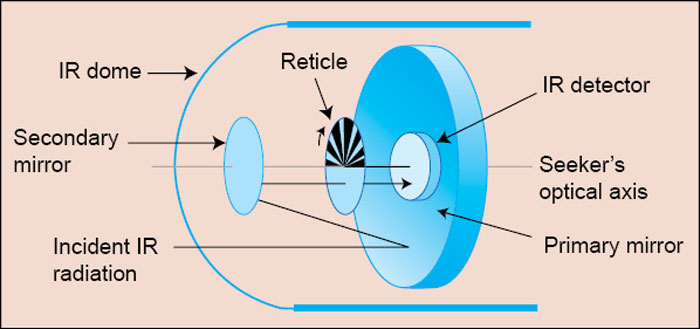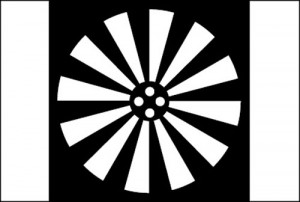IR-guided missiles developed in 1970s and 1980s used single-colour IR seekers employing 3-5 micron band. IR seekers used in these missiles were most effective in detecting IR radiation of shorter wavelengths such as 4.2 micron emission of carbon dioxide efflux of a jet engine. Seekers responding to 3-5 micron band were called single-colour seekers and missiles as single-colour missiles.
MAGIC series air-to-air missiles from France and R-73 air-to-air missiles from Russia are some examples. State-of-the-art IR-guided missiles use seekers that respond to both 3-5 and 8-12 micron bands to offer improved false alarm rejection and immunity to deception by flares. These seekers are called two-colour seekers and missiles, two-colour missiles. Python from Israel and RVVAE from Russia are examples of missiles using two-colour seeker heads.
Also, both surface-to-air and air-to-air IR-guided missiles receive target’s IR signatures in the presence of background radiation from the sky and also IR signatures of flares, if any, deployed by the target aircraft platform. The seeker head should be able to discriminate between IR signatures of the background and flares from those of the target.
Advantages and limitations
IR-guided missiles and radar-guided missiles are deployed in similar roles, predominantly as surface-to-air and air-to-air guided weapons. It would therefore be nothing but logical to compare the two types of guided weapons.
IR-guided missiles offer several advantages over radar-guided missiles. One, IR-guided missiles are far more immune to electronic countermeasures than their radar counterparts.
Two, IR-guided missiles offer greater safety of pilots of the aircraft carrying these weapons. Due to the inherent fire-and-forget capabilities of IR-guided missiles, after releasing the missile, the pilot can leave the area while the missile guides itself to the target.
Three, IR-guided missiles are almost impossible to detect during launch preparation. On the other hand, radar-guided missiles employ either beam rider or semi-active or active guidance. In all forms, it employs a radar, which can be detected through radar emission during launch preparation or flight.
Four, IR-guided missiles are manoeuvring missiles and are particularly suitable for close engagement.
Five, IR sensors perform well during day and night conditions.
Six, IR sensors employed by heat-seeking missiles cost less per unit.
While radar-guided missiles are all-weather weapons and have relatively much longer operational ranges, heat-seeking missiles perform better in close-in ranges. Also, heat-seeking missiles are vulnerable to the use of passive and active IR countermeasures. Use of chaff, decoys and flares to deceive heat-seeking missiles is a common occurrence. Heat-seeking missiles employing IIR seekers though are far less vulnerable to these countermeasures.
In the early days of development of heat-seeking missiles, these missiles could only lock on to intense sources of heat such as jet exhaust pipes, and therefore could be fired only from behind the aircraft. Present-day missiles using advanced IR sensors can even lock on to friction-heated air streaming back from the aircraft’s nose. These missiles can be fired from any angle.
IR-guided-missile seekers
Two broad categories of seekers are used in heat-seeking missiles. These are reticle seekers using single IR detectors and imaging seekers that use a focal plane array of IR/UV detectors. Both types have different variants.

In the most basic reticle seeker (Fig. 6), IR energy emitted by the target is collected by the

optical system and focused on the detector through a rotating reticle. A reticle is nothing but an optical modulator made up of a circular element having sequentially-arranged transparent and opaque spokes on it (Fig. 7). The reticle chops the scene represented by IR energy. The output of the detector is a sequence of pulses whose amplitude is proportional to the magnitude of IR energy and whose frequency is equal to the product of spin rate of the reticle and the number of transparent/opaque spoke pairs.
Also, modern reticle-seeker based heat-seeking missiles use spinning mirrors and a fixed reticle. The phase of detector signal with respect to a reference phase is used to determine the angular position of the seeker axis with respect to the target. The angular error is then used to keep the seeker axis pointed towards the target within its field-of-view and also control the flight path of the missile to intercept the target.
We have spin-scan seekers that suffer from the problem of centre-null and conical-scan seekers that eliminate this problem. We shall not go into details of these techniques. Lead-sulphide (PbS) with peak sensitivity in the wavelength region of two micron when uncooled, indium-antimonide (InSb) with peak sensitivity in 4-5 micron band when cooled to liquid nitrogen temperature and mercury-cadmium-telluride (HgCdTe) with peak sensitivity in 8-12 micron band when cooled to liquid nitrogen temperature are the commonly used detector materials.










